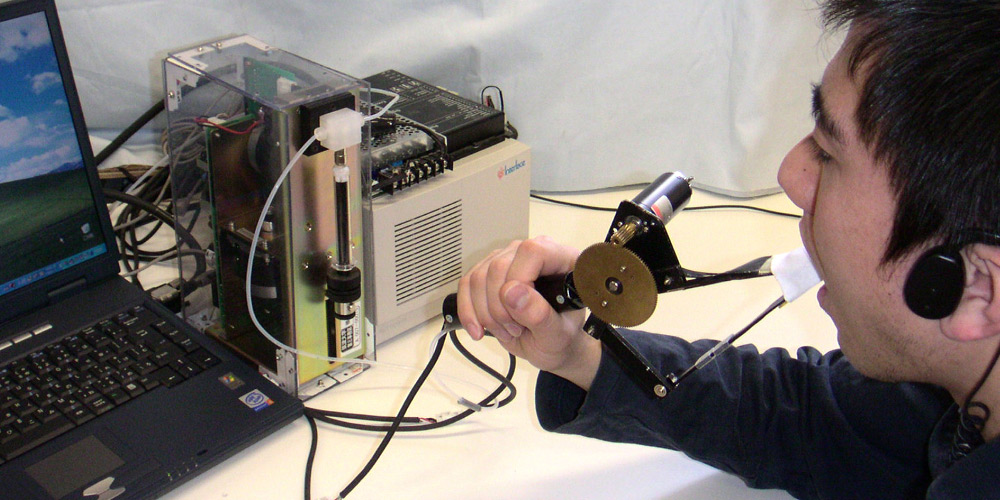
The human camery “Touchy” is part of the exhibition “Device Art”. Photo: Eric Siu
Device Art is an art form that emerged 10 years ago. In these technical devices, playfully creative design encounters ancient Japanese traditions. An entire level of the Ars Electronica Center is dedicated to the “Device Art” exhibition running from September 4, 2014 to the end of June, 2015. Here, Hiroo Iwata, a professor at Tsukuba University in Japan and one of those who was present at the birth of Device Art, previews the exhibition and explains how the essence of technology is perceived, above all in Japanese society.
What are the requirements of a device to be included into the collection of “Device Art”?
Hiroo Iwata: First of all: The device itself is content. The mechanism represents the theme of the piece. Content and tool are no longer separable. Secondly, the artworks are often playful and can sometimes be commercialized into devices or gadgets for use in everyday life.

Food Simulator generates force according to the captured force of real food. Photo: Hiroo Iwata
The cultivation of everyday objects and everyday actions has a long tradition in Japan – what’s the difference to Western cultures in this way of seeing?
Hiroo Iwata: Device Art evolved from a background of manufacturing traditions and a Japanese aesthetic. In traditional Japanese culture there are crafts in which technology and art meld in an indistinct combination, and it is possible to view Device Art as a new art form for the digital age. Unlike Western art, which is generally viewed in galleries and museums, in Japan artworks have been something to be enjoyed as a part of everyday life. A typical example of this is a tea ceremony room, which abounds with works of art—tea utensils, flower vases, etc.
Could you explain to us Europeans what’s all about the tea ceremony room that will be included in the exhibition?
Hiroo Iwata: In order to express the vision of enjoying Device Art in familiar, everyday surroundings as crafts, a display area resembling a tea ceremony room has been created. The Device Art has been integrated into structural elements of a tea ceremony room, such as the tokonoma alcove and roji garden, enabling one to image the connection with everyday living spaces.

Mr. Knocky is one of the playful devices. Photo: Novumichi Tosa
Could “Device Art” be defined as a combination of playfulness and seriousness?
Hiroo Iwata: This question is closely related to the theme of the Campus Exhibition of University of Tsukuba that took place in the Festival Ars Electronica 2011. The title was “Seriously Playful / Playfully Serious”. Many famous media artists, including Maywa Denki and Ryota Kuwakubo, graduated from this school and innovative, interactive technologies have been developed at the University of Tsukuba’s Department of Engineering. In 1996 I started to present interface devices as a form of artistic expression, setting an example that was followed by many future Ars Electronica participants. At the University of Tsukuba a discussion on the characteristics of art took place, in which the keywords “playful” and “serious” acquired particular significance. Artists at the School of Art and Design take the playful element very seriously, whilst serious engineering projects often display playful elements. These conceptual features characterize the work of Device Art.
How and when did the movement “Device Art” start?
Hiroo Iwata: The Device Art project is funded by Core Research for Evolutional Science and Technology (CREST) of Japan Science and Technology Agency finanziert. I conduct the project, its formal title being, “Expressive Science and Technology for Device Art.” The name and concept of Device Art came about during the process of its creation in 2004.
The vernissage in the Ars Electronica Center is set for Wednesday, September 3, 2014 at 6:30 PM, and thus the evening prior to the opening of the Festival „C … what it takes to change“. Stop by! Details about the opening program are online at ars.electronica.art/center. To go more deeply into this subject, attend the Device Art Symposium.
